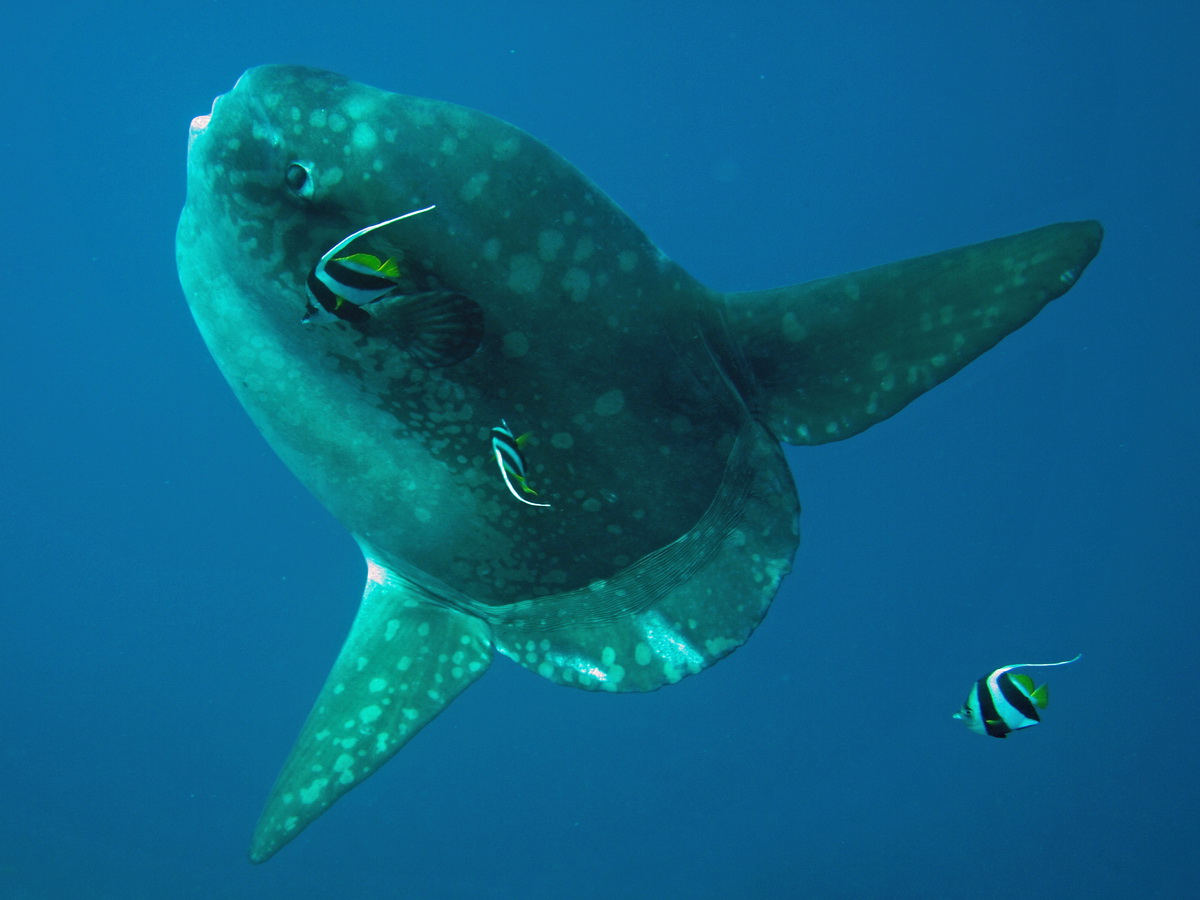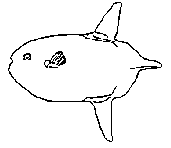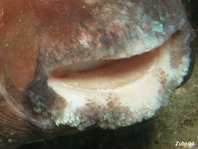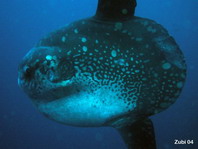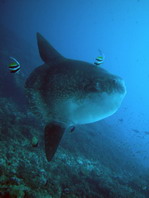|
|
||||||||
Multi-celled animals |
||||||||
BONY FISHES |
CHORDATA (VERTEBRATES)
|
|||||||
|
The family of Molidae belongs to the order of Tetraodontiformes
(trigger fish, boxfish, porcupine fish, puffers). The ocean sunfish (Mola mola) is the world’s largest known bony fish (whale sharks are cartilaginous) with about 3m length from fin tip to fin tip and weighting 2 tons (see comparison of sunfish with the size of a human) |
|||||||
|
|
||||||||
| Mondfische (Molidae)
Mola mola (Oceanic sunfish, Roundtailed or Common mola) |
CharacteristicsTheir characteristic body shape is unique and is about the most peculiar sight you might encounter while diving. They seem to have no caudal fins at all (this rudder-like structure is called clavus), the body is large and flattened and their eyes and mouth are very small. They possess sharp edged plates of fused teeth in the jaws, which are typical of puffer fish. The scaleless body is covered with a tough, leathery skin about 15cm thick. Silvery to brownish gray or a blue motteled colour. The gill openings are small and just behind them are the small pectoral fins. The dorsal and anal fins are large and look like paddles. They are flapped synchronously from side to side (like the triggerfish) and can propel the fish at surprisingly good speed. Adults have no swimbladder. Ecology and rangeSunfishes are found in all oceans in tropical and temperate climes, but prefer open ocean. They are adapted for life as a sluggish, pelagic predators of jellyfish or other larger invertebrates that come close enough to be sucked in. Probably they inhabit the mesopelagic zone down to about 1000 meters, but live most commonly about 300m deep. |
|||||||
|
||||||||
|
Detail of mouthwith sharp edged plates of fused teeth of a porcupinefish (relative to sunfish) detail of bannerfish cleaning ocean sunfish - Mola mola |
BehaviorMolas are considered to be among the most fecund of all vertebrates, producing more that 300 million eggs, each about 2 to 3mm large. The larvae look much more like their close relatives, the puffer or porcupine fishes with needlelike spikes. As they grow their body flattens and the spines and their tails disappear. Molas have a very small mouth that they can't close and they posses a parrot-like beak formed by sharp edged plates of fused teeth. This is also typical of puffer fish. Mola mola eat a variety of foods, but mostly gelatinous zooplankton (jellyfish and salps) as well as squid, sponges, serpent star, eel grass, crustaceans, small fishes and deepwater eel larvae. Molas forage both at the surface, among floating weeds, on the sea floor and in deep water. They are well adapted to eat jellyfish because their thick skin provides armor against the stinging barbs. Ocean sunfish render their prey into bite-size pieces before ingesting the morsels by sucking in their prey and spitting it out again. They have long, claw-like teeth in their throat. Molas are not highly desirable as food, since their meat may contain the same toxin as puffers and porcupine fish. The sunfish can probably get over 100 years old. The common sunfish, Mola mola, are often covered with parasites. Some 40 different genera of parasites have been recorded on this species alone. To get rid of these them they approach drift kelp and other flotsam to recruit small fish living there to clean them. In southern California the sunfishes surface and seagulls pick these parasites off them. They often drift at the surface while lying on their side, or swim upright and close to the surface that their dorsal fin projects above the water like a large shark fins. Here Molas are also commonly observed jumping out of the water. In Bali the Mola Mola come relatively close to the reef to certain cleaning stations where groups of the bannerfish (Heniochus diphreutes) literally "attack" them, eating the parasites that infest their skin. If a sunfish comes even closer to the reef, angelfishes and sometimes other butterflyfishes also go after the parasites. |
|||||||
| Names: sunfish (English), Mondfisch (German for moonfish) Manbow or Manbo (Japan), Poisson lune (France), Putol (Philippines - Visaya for "cut off"), Toppled car fish (Taiwan), Bezador or Pez luna (Spain), Makua (Hawaii). | ||||||||
Photos of sunfish (photo collection with more) click for enlargement
|
||||||||
index coral reef - starfish site mapLINKS ABOUT FISHES |
||||||||
. Copyright Teresa Zubi
